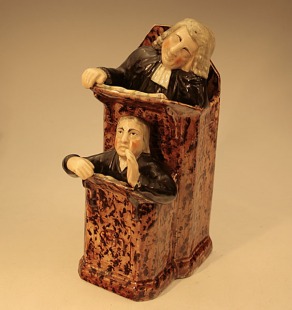
But now we start down a slippery slope. It seems these figure groups were produced perhaps into the 20thC. Examples occur that just don't appear to be early. The colors and glazes are not quite what they should be, and the group always seems particularly lifeless. Nothing humorous or engaging here. The group illustrated is coming up for auction in the UK this month, cataloged as LATE 19thC. Hallelujah! Credit to the auction house, Mellors and Kirk, for not claiming an earlier date, as so many other vendors do.
When was this figure group made? I don't know. Australia's Powerhouse Museum has an example that was donated in 1927, so we can assume all examples probably predate that. Circa 1900? Who's to say? We just don't know. But we do know that this figure is NOT an early 19thC Staffordshire figure.
The Internet bring us many curses and blessings. On the positive side of the equation: we now see very many more figures, so it is possible to be increasingly aware of this figure group's existence. But don't let it fool you!

The inspiration for this figure group was a Hogarth's engraving of "The Sleeping Congregation", published first in 1736. In an era when the clergy was notoriously lazy, the figure group appealed because it shows the vicar sleeping soundly in his pulpit, while the clerk, Moses, delivers the sermon.

















